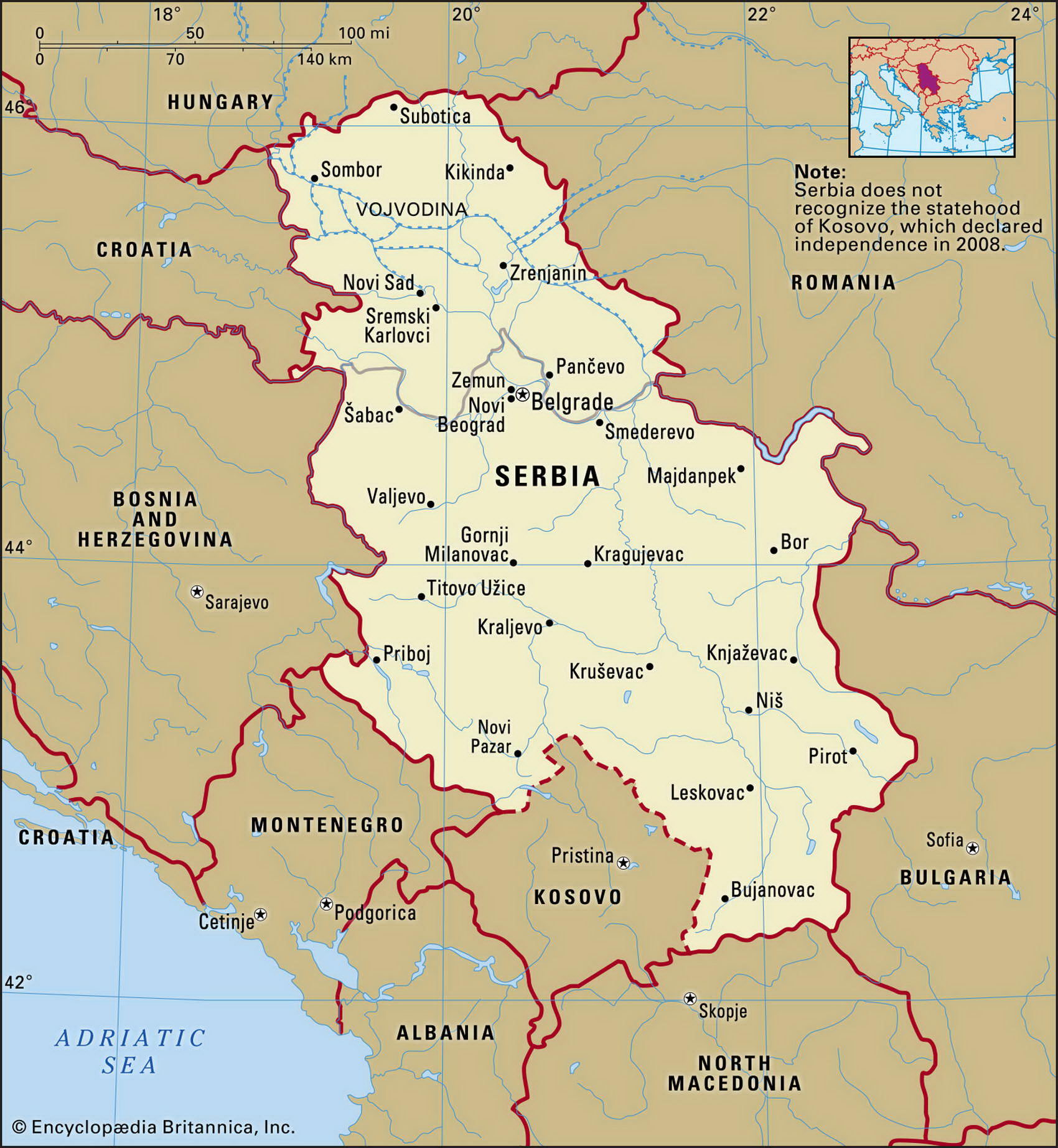Map of Serbia and Montenegro and geographical facts
Serbia and Montenegro on the world map. Map of Serbia and Montenegro
Map of Serbia and Montenegro with cities. Where Serbia and Montenegro is on the world map. The main geographical facts about Serbia and Montenegro - population, country area, capital, official language, religions, industry and culture.

Serbia and Montenegro Fact File
Official name Serbia and Montenegro
Form of government Federal republic with two legislative bodies (Chamber of Republics and Chamber of Citizens)
Capital Belgrade
Area 102,350 sq km (39,51 7 sq miles)
Time zone GMT + 1 hour
Population 10,657,000
Projected population 2015 10,309,000
Population density 104.1 per sq km (269.7 per sq mile)
Life expectancy 73.7
Infant mortality (per 1,000) 1 7.4
Official language Serbian
Other languages Albanian, Hungarian
Literacy rate 93%
Religions Eastern Orthodox 65%, Muslim 19%, Roman Catholic 4%, Protestant 1 %, other 11 %
Ethnic groups Serbian 63%, Albanian 14%, Montenegrin 6%, Hungarian 4%, other 13%
Currency Dinar
Economy Not available; war disrupted employment
GNP per capita US$2,370
Climate Temperate, with cold winters and hot summers
Highest point Daravica 2,656 m (8,714 ft) Map reference Page 296
At its southwestern edge, Serbia and Montenegro, the "rump" republic of Yugoslavia, has a toehold on the Adriatic Sea. Otherwise it is landlocked, sharing borders with seven countries. Moving from the west around to south clockwise, these are Bosnia and Herzegovina, Croatia, Hungary, Romania, Bulgaria, Macedonia, and Albania. Serbia and Montenegro now comprises the republics of Serbia and Montenegro—all that remains of the former federation of Yugoslavia after four of its six constituent republics, Slovenia, Croatia, Bosnia and Herzegovina, and Macedonia— seceded in the early 1990s.
Yugoslavia came into existence in December 1918 as a combination of formerly separate Balkan states, most of which had been under Austro-Hungarian control. Serbia had become independent in 1878, bringing to an end five centuries of almost continuous Ottoman rule. The new country was originally called the Kingdom of Serbs, Croats, and Slovenes, but in 1929 the name Yugoslavia was adopted. During the Second World War Yugoslavia was invaded by Germany and the country was further devastated by civil war. More than a million Yugoslavs perished during this time. At the end of the war a communist government led by a Croat, Josip Broz, better known as Marshal Tito, came to power, but remained independent of the Soviet Union. After Tito died in 1980 ethnic tensions began to assert themselves, and in 1991 Croatia and Slovenia seceded, leading to four years of bitter ethnic-based conflict between Serbia and its neighbors. In the Kosovo province, mainly inhabited by muslim Albanians, the ethnic conflicts persisted. In 1999, after initial opposition of the Russian government, an international alliance and NATO reacted to massive actions of the Serbian army by bombing Yugoslavia. An international peace-keeping force led by Russia and the US has been installed in Kosovo since 2000. In the fall of 2000 elections brought reformers into power and in March 2003 a new constitution replaced the federal republic by the union of two states, Serbia and Montenegro. Each has their own president and parliament, but there is also one president heading the entire country as chief of state and leader of the government. A referendum in 2006 is planned to decide whether the union will persist.
Serbia and Montenegro are largely mountainous. The rocky peaks of the heavily forested Balkan Mountains separate Serbia from Bulgaria and Romania and stretch across much of southern and central Serbia and into Bosnia and Herzegovina. Much of Montenegro, in the southwest, is covered by the bare limestone ridges of the Dinaric Alps, which run from Slovenia south into Albania. In the north of the country and covering most of the province of Vojvodina, is the fertile Pannonian Plain. A number of rivers including the Sava, the Tisza and the Danube traverse this plain, which extends northwest into Croatia and Hungary.
Agricultural produce is centered on the northern plain, which supports substantial crops of wheat, maize, and vegetables as well as livestock and poultry. Agriculture in Montenegro is based mainly on the raising of sheep and goats. Serbia and Montenegro has considerable reserves of coal and petroleum and is largely self-sufficient in fuel. Most of these resources are in the northern province of Vojvodina and the troubled southern region of Kosovo. Mining and heavy machine manufacture are major contributors to the country's economy which, however, especially in Serbia remains seriously destabilized by years of warfare and the consequent disruption of trade links.